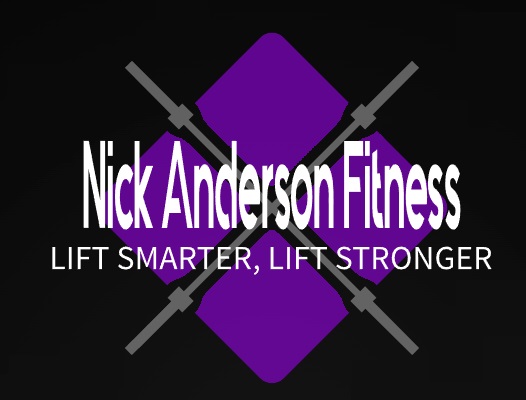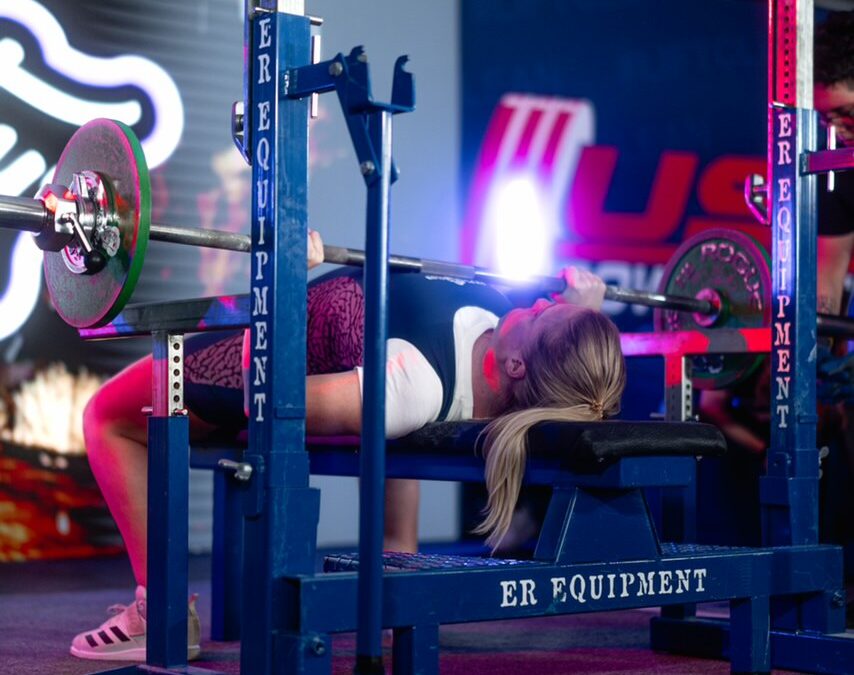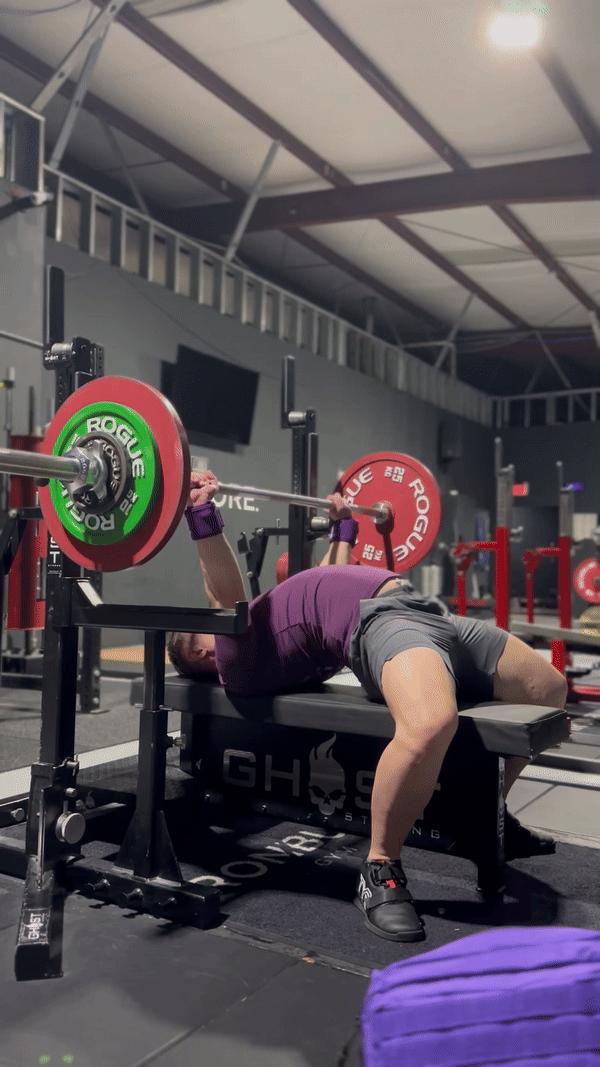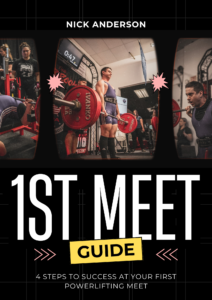Finding the right bench press grip width can make all the difference in the strength of your press.
Beneath the surface level straightforwardness of the bench press lies a world of nuance.
From grip width to bar path, even minor adjustments can unlock hidden potential in your pressing power.
Your bench press journey is a continuous quest for optimization.
As you gain strength and experience, what works best for your body might evolve.
While fundamental form principles exist, individual differences play a significant role.
This is where bench press grip width enters the picture, a seemingly simple detail with far-reaching consequences.
Understanding Bench Press Grip Widths
To better understand which bench press grip width is right for you, we must first define what constitutes a close, moderate and wide grip.
Close Grip – Index finger on inner edge of knurling to halfway to knurl marks
Moderate Grip – Index finger halfway between knurling inner edge and knurl marks to ring fingers on knurl marks
Wide Grip – Ring fingers on knurl marks to index finger on knurl marks
Any wider than index fingers on knurl marks and it is outside of the maximum grip allowed for most powerlifting federations
Close Grip Bench Press
As mentioned above a close grip bench press is when your index fingers are between the inner edge of the knurling to halfway to knurl marks, and all ranges in between.
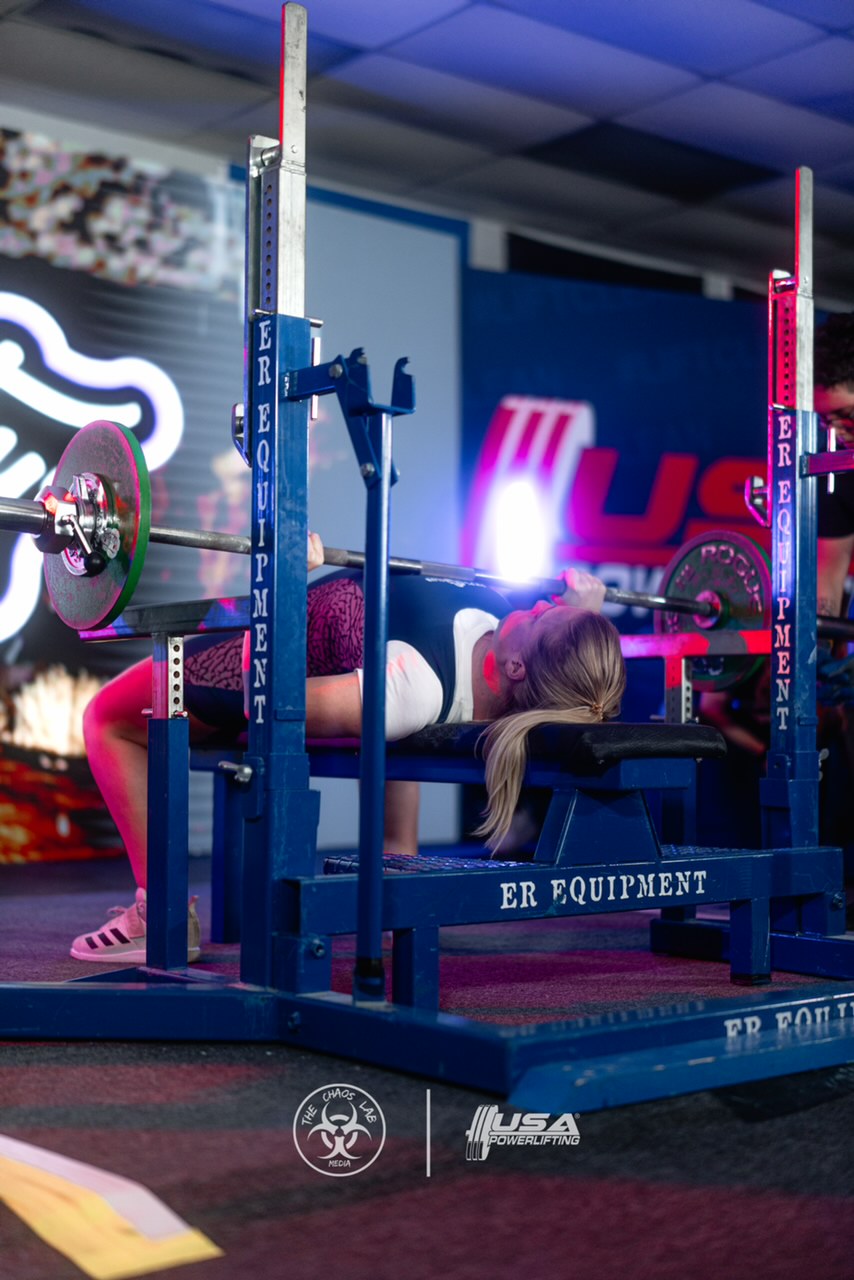
Potential Benefits
Accessory Muscle Development
The close grip bench press increases the activation from your triceps.
The narrower hand placement forces the elbows to bend more, and the increased elbow flexion creates a targeted stimulus for tricep growth and strength.
Strong triceps are essential for powerful bench presses, and the close grip provides a direct path to achieving that goal.
If you wanted bigger triceps, you could just to tricep extensions, or tricep pushdowns until your elbows cried uncle.
While doing tricep pushdowns on a cable machine does have benefits, there’s a difference between that and actually putting a barbell in your hand and strengthening your triceps by doing the movement pattern you need to do in competition.
The close-grip bench press isn’t a tricep isolation exercise in a vacuum.
It engages your engages your anterior delts (shoulders), pecs, and core to stabilize the movement.
Strengthening these accessory muscles contributes to overall stability and power transfer.
Improved Technique
The close grip acts as a form check for your lats.
The narrower grip forces you to actively engage your lats, which is essential for maintaining proper elbow tuck and preventing elbow flare.
By maintaining your elbows tucked closer into your sides, this helps you activate your lats, which is crucial to a strong bench press.
You can immediately feel if your elbows flare to wide, as your lats will become more disengaged and you’ll struggle to maintain a stable barbell through the movement.
By using close grip (whether it is your preferred position or not), you can refine your setup and bar path for a more efficient and safer competition bench press.
Addressing Weaknesses
The close grip press can expose a weakness in your lockout strength, a common sticking point for many powerlifters.
If your bench press tends to fail at the top half towards lockout, you can address this weakness by increasing the strength of your triceps.
Reduced Training Stress
The close-grip press allows you to work on pressing mechanics and tricep strength without putting the same level of stress on your shoulders and central nervous system compared to a heavy competition bench press.
Potential Drawbacks
Increased Range of Motion
The close grip bench press forces you to have to tuck your elbows in closer to the sides.
This has an effect on where the bar touches on your chest, which is generally further down the chest than with the moderate or wide grip bench.
Since your bar path changes to a lower point, the bar has to travel a further distance.
Powerlifting is a sport where every inch matters, so the further distance could potentially have an impact on how much weight you can lift
Increased Stress on Wrists and Elbows
Beginner lifters tend to complain about wrist pain with the close grip bench.
This can be just a simple technique issue, as the wrists tend to hyperextend to compensate for the increased range of motion.
But in beginner lifters, it can also be because the wrist joint hasn’t built up enough stability to maintain position under load.
The elbow can also tend to get worn down over time, as the range of motion at the elbow is significantly greater in the close grip bench.
Increased Stress on Shoulders
For some lifters, keeping the elbows in can bother their shoulders.
For others, it’s perfectly fine, and actually feels better on their shoulders than anything.
This is a highly individualized topic, and you are the only person who can determine which feels best for you.
Biomechanics
Elbow Angle
With the close grip bench press, it’s beneficial to overemphasize how much you tuck your elbows.
Keeping the elbows in tight keeps your elbows directly under your wrists while your hands are in closer.
Touchpoint
As you overemphasize your elbow tuck, the point where the bar touches your chest will change to a lower spot.
You’ll likely aim for under the bra line, or the upper edge of the abdomen.
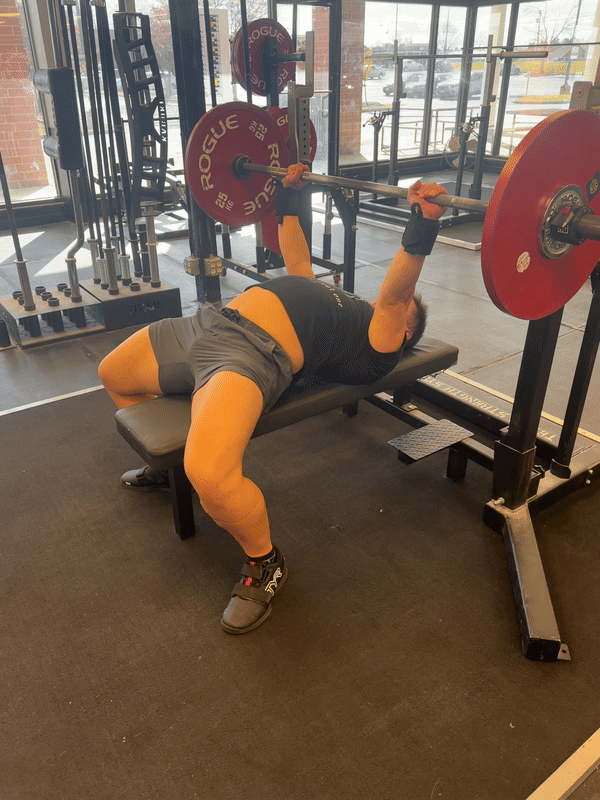
Moderate Grip Bench Press
A moderate grip is the range between your index finger halfway between knurling inner edge and knurl marks, to ring fingers on knurl marks

Potential Benefits
More balanced
For most lifters, the moderate grip bench press is the golden standard.
It offers a balanced approach, engaging your chest, triceps, and shoulders fairly uniformly.
This translates to efficient movement patterns, maximizing your strength potential, while allowing for a straightforward bar path and chest touchpoint.
Unlike its extreme counterparts, the moderate grip avoids the pitfalls of the close grip and wide grip.
More natural movement pattern
If you were to push a car, you’d probably take a moderate hand width.
You wouldn’t flare out super wide, or keep the hands in super close.
The moderate grip bench press is the most natural path for your body to take.
It allows for natural and sustained lat tension.
This translates to better back support and stability throughout the lift, minimizing the risk of injury and maximizing your ability to move heavier weights.
This also helps you maintain a strong core and upper back engagement throughout the entire movement.
More sustainable long term
While some lifters might experiment with extreme technique variations, these often prove unsustainable in the long run.
The key lies in finding the a bench press grip width and body position that allows for efficient movement mechanics, and minimized risk of injury.
This allows you to train consistently for months, progressively building strength over time.
Of course, there are exceptions.
Elite athletes and individuals with unique body types might find success with more unorthodox techniques.
But for most lifters, focusing on more of a middle ground in technique is the path to consistent and sustainable progress.
Moderate Range of Motion
By keeping your hands wider than the close grip, the range of motion will be less than the close grip.
However, it will also be more than the wide grip.
Biomechanics
Elbow Angle
Unlike the close grip counterpart, the elbow is not going to tuck in close to the sides.
And unlike the wider grip bench, the elbows won’t flare out wide.
The moderate grip is all about the balanced point in between the two.
Remember, your best elbow angle is going to stack the elbow joint directly underneath the wrist in a vertical line.
Once you lose that joint stack, that’s where inefficiencies shine through.
Touchpoint
The touchpoint will be much higher in the moderate grip press than the close grip.
For most people, it will be somewhere on the lower end of the breastbone, very near the nipple line.
Wide Grip Bench Press
A wide grip is defined as ring fingers on knurl marks to index finger on knurl marks. Anything wider than this is against the rules of most powerlifting federations.
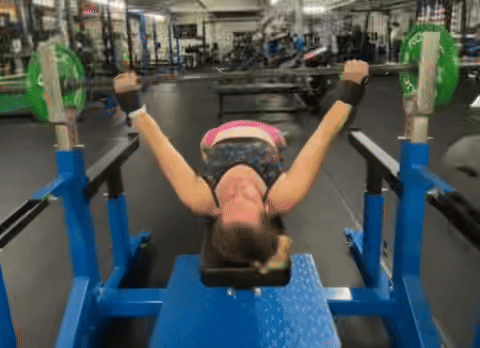
Potential Benefits
Reduced Range Of Motion
Due to the wider hand placement, the bar travels a shorter distance during the wide-grip bench press.
This can be beneficial for lifters with limitations in their shoulder mobility or those recovering from injuries.
It also allows you to potentially lift heavier weights because you’re moving the weight through a shorter distance.
Higher Pectoral Activation
The wide bench press grip width emphasizes chest muscles to a greater degree compared to a narrower grip.
This can be valuable for strengthening these specific portions of the chest, contributing to a stronger overall pressing motion.
The chest is a larger muscle than the delts or the triceps that are more involved in the moderate to close grip options, so it has potential for more strength.
However, there is serious benefit to recruiting muscles to help your chest out in the bench press.
Decreased Stress On Shoulders
When proper elbow tuck is maintained with a wider grip, it can theoretically decrease stress on the shoulder joints compared to a close-grip bench press.
This allows powerlifters to focus on maximizing bench press strength without excessive shoulder strain.
Potential Drawbacks
Increased Stress On Shoulders
But I just said that it can decrease stress on your shoulders didn’t I?
While a wider grip can theoretically decrease stress on the shoulder joints compared to a close-grip bench press when proper elbow tuck is maintained, shoulder pain can still occur in many different positions.
A close grip can irritate them by angling the arm in.
A wide grip can irritate them by angling the arm out.
This is highly individual, and the only person who knows which position (if any) causes discomfort is you.
Maintaining and improving shoulder mobility is helpful for all grip variations.
This helpful guide discusses various exercises to improve mobility for powerlifters, which can benefit your pressing technique across the board.
Heavy Reliance On Pec Strength
The wide grip requires significant chest strength to lift heavy weight.
If you don’t have a disproportionately strong chest, this may not be the grip for you.
Biomechanics
Elbow Angle
To maintain keeping your wrists and elbows in a vertical line, the elbows will have to flare out wider.
Touchpoint
The touchpoint for the wide grip will be the higher of the three options.
You should be hitting higher on the pec, above the nipple in this position.
Choosing Your Competition Bench Press Grip Width
Now that we’ve explored the close, moderate, and wide grip bench press variations, it’s time to find your ideal competition bench press grip width.
This sweet spot maximizes your strength potential while minimizing risk of injury over the long term.
Here’s how to navigate this decision:
Start Moderate, Tailor Later
For most lifters, a moderate grip width is the starting point.
It provides a balanced activation of your chest, triceps, and shoulders, leading to efficient movement patterns and a straightforward bar path.
This “middle ground” approach minimizes the drawbacks of the extreme close and wide grip variations.
Ready to take your bench press training to the next level and compete in your first powerlifting meet? My
free guide, First Powerlifting Meet Guide: 4 Steps to Success at Your First Powerlifting Meet, walks you through everything you need to know. From demystifying the rules and competition format to developing a strategic warmup and fueling plan, this guide equips you to approach meet day with confidence and perform at your peak.
Download your free copy now and ensure a smooth and successful competition experience!
I like to use pinky fingers on the knurl marks as a starting point for the lifters I coach, and then from there we can tinker.
Generally, I have them play around with one finger width at a time for different setup.
I’m not going to take them from pinkies on the knurl marks to all the way to index fingers on the knurl marks in one go.
It’s best to experiment with grip widths little by little.
General Guidelines (Not Rules)
Long Arms & Mid-Range/Lockout Sticking Point
If you have longer arms and struggle with sticking points in the mid-range or lockout with a moderate grip, a slightly wider bench press grip width might be beneficial.
This shortens the range of motion, allowing you to potentially grind through those sticking points.
Shorter Arms & Off-the-Chest Sticking Point
Conversely, lifters with shorter arms who struggle to get the bar off their chest with a moderate grip might find some success with a slightly closer grip.
This allows for a more natural pressing motion and potentially a stronger start to the lift.
Beyond Arm Length – Individuality Matters
These are just general guidelines. Injuries, shoulder mobility, and personal preference all play a significant role.
Experiment with different bench press grip widths during training sessions to see what feels strongest and most stable for you. Pay close attention to:
- Pain-Free Pressing: The most important factor is pain-free pressing. If a specific grip width causes discomfort, it’s probably not your best position.
- Efficiency and Stability: Choose a bench press grip width that allows you to maintain proper form throughout the entire lift. This includes keeping your core engaged, back tight, and elbows tucked in at an appropriate angle. If your technique isn’t perfect right off the bat, that’s normal.
- Bar Path and Touchpoint: The grip width will influence your bar path and touchpoint on your chest. Find a combination that feels natural and allows for a powerful pressing motion.
There’s no “one size fits all” answer.
While some elite powerlifters might find success with very wide or close grips due to unique body types, most athletes will find their power zone within the moderate grip range.
Focus on finding a bench press grip width that allows you to press safely, efficiently, and with maximum strength potential.
Incorporating Varying Grip Widths In Training
While you’ve honed in on your competition bench press grip width, incorporating other variations into your training offers strategic benefits:
Close-Grip Bench for Triceps and Lockout Strength
The close-grip bench press serves as a fantastic secondary bench press exercise.
By placing more emphasis on your triceps, it can help you address weaknesses in lockout strength, a common sticking point for many powerlifters.
Think of it as targeted training for that crucial lockout phase of your competition bench press.
Wide-Grip Bench for Off-the-Chest Strength
The wider grip variation can be a valuable tool for developing strength off the chest.
This can be helpful for lifters who struggle to initiate the press with a moderate grip.
However, remember that the wider grip can be more stressful on the shoulders.
Offseason Grip Variation Training
During the offseason, when competition intensity isn’t the primary focus, incorporating wider and closer grip variations into your training program can be beneficial.
This allows you to explore different movement patterns, build overall upper body strength, and potentially identify new areas of strength development that can translate back to your competition grip later.
Conclusion: The Nuance of Grip Width
The bench press might seem simple, but grip width plays a surprising role in maximizing your strength and safety.
Experiment with close, moderate, and wide grips to find your personal sweet spot.
There’s no one-size-fits-all answer, so listen to your body and prioritize the grip width that feels best and strongest for you.
Utilize different grip variations strategically to target weaknesses and build well-rounded pressing power.
Ready to translate your newfound bench press grip width knowledge into a dominant competition performance?
Don’t navigate meet day alone!
My free guide, First Powerlifting Meet Guide: 4 Steps to Crushing Your Competition Debut, equips you with the tools and strategies to conquer every aspect of your first powerlifting meet.
From demystifying competition rules to developing a strategic warmup and fueling plan, this guide sets you up for a confident and successful experience.
